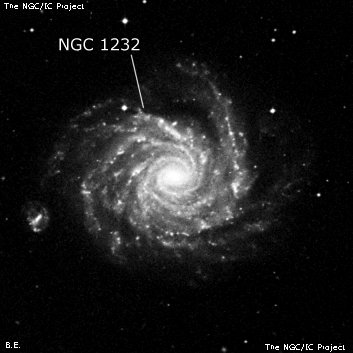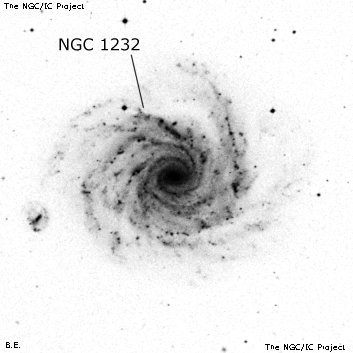NGC/IC Project Restoration Effort
(This is a very very beta version)
NGC1232


Basic Information
Location and Magnitude
Right Ascension: 3:9:45.3
Declination: -20:34:45
Constellation: ERI
Visual Magnitude: 9.9
Historic Information
Discoverer: Herschel W.
Year of discovery: 1784
Discovery aperture: 18.7
Observational
Summary description: pB, cL, R, gbM, r
Sub-type: SBc
Steve's Notes
=====
NGC 1232
30" (10/15/15 - OzSky): at 303x; this face-on multi-arm knotty Sc appeared very bright, very large, roundish, at least 6' diameter. Sharply concentrated with a very bright, elongated core that contains a brighter central bar-like nuclear region. Spiral structure is evident in the large halo, but more subtle than I expected as several segments are disconnected. Most prominent is a knotty arm on the north side. It emerges near the northwest end of the core and shoots linearly (2' length) towards the northeast in the direction of a mag 14 star 2.5' NE of center. Another spiral arm extends east and west perhaps 1.5' length, just south of the central region. The arm fades out at its west end but after a short break, a very faint elongated knot, ~14"x8", is visible 1.7' WSW of center. NED includes multiple designations NGC 1232:[HK83] 442, [HK83] 445, [HK83] 450 and more from Hodge and Kennicutt's 1983 "Atlas of HII regions in 125 galaxies". The arm dims again but can just be traced shooting straight N-S in the northwest end of the halo. Another short, linear segment of a arm (containing [HK83] 110) is just visible close east of the core, 1.1' ENE of center. NGC 1232A (the subject of a long-standing redshift controversy) is visible 4.1' ESE of center, just beyond the east edge of the galaxy. It appeared very faint, small, round, ~20" diameter
17.5" (10/8/88): bright, large, slightly elongated, bright core, very large faint halo. Located 8' WSW of mag 8.6 SAO 168347.
13" (1/18/85): large, large bright core, substellar nucleus, very diffuse outer halo. An arm is suspected attached at the west end and winding towards the east on the north side of the core.
8" (10/13/81): faint, diffuse, low surface brightness.



